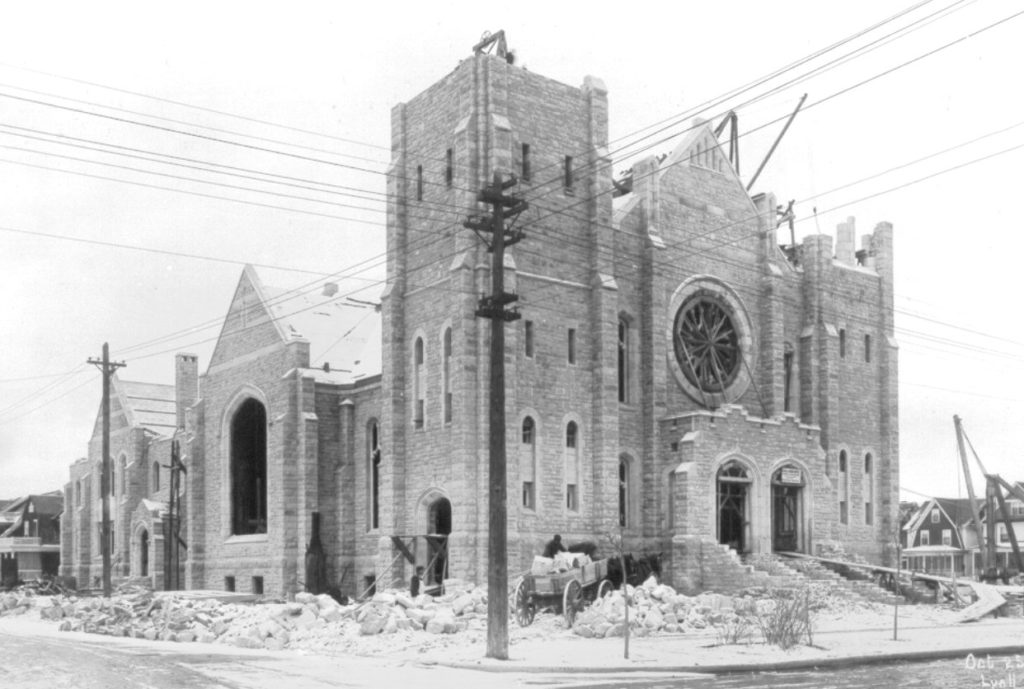
/ Blog
February 12, 2020
Behind the Stained Glass: Westminster United Church
Since 1992, the Westminster United Church has been both a municipally and provincially designated heritage building. It’s a well-earned designation; the Westminster Church is a distinctive landmark in the neighbourhood of Wolseley and has played an important role in the community since its 1910 construction. Today, the church is a part of the United Church of Canada – a Protestant denomination created in 1925 that merged the Union of Methodists, Presbyterian, and Congregational church. However, the Westminster Church was not always a part of this group; in 1910, it serviced just the Presbyterians in Winnipeg, who already had a long and established history in Winnipeg.
Many of these new settlers were members of the Church of Scotland, a Presbyterian denomination. With no church to worship at in their new homeland, they attended services offered by the Church of England (which was Anglican). Finally in 1854, the Kildonan Presbyterian Church at 201 John Black Avenue opened, spearheading the spread of Presbyterianism across the prairies. What followed was decades of growth and prosperity of the community, and the first Knox Presbyterian Church at the corner of Fort Street and Portage Avenue opened in 1868. As more settlers arrived in the area and Presbyterianism prospered, a second congregation, St. Andrew’s Presbyterian Church was established in 1873 to served the northern half of the community. A proper church had yet to be built (it would open in 1894), the St. Andrew’s congregation held services at Winnipeg’s City Hall and Court House.
 |
| Kildonan Presbyterian Church circa 1870. Source: City of Winnipeg. |
Yet by 1892, before St. Andrew’s could even be built, it was recognized that a new congregation was needed to serve Winnipeg’s central community. A group of 18 parishioners from St. Andrew’s obtained permission to create a new congregation which would be called Westminster. Dr. Pitblado, who had served as minister of St. Andrew’s from 1881 to 1889, returned from California to lead the new church. The first service of the Westminster congregation was held on January 1st, 1893, with over 200 people crowded in Victoria Hall (later renamed the Bijou Opera House) on Notre Dame Avenue. After holding services in a variety of locations, the congregation finally opened the doors to their own building at the corner of Notre Dame Avenue and Hargrave Street (then Charlotte Street) in 1894. It was a stately brick building with elegant arched roman windows and a tower the would have stood tall over the burgeoning prairie city. Only 15 years later the congregation had tripled, outgrowing its quaint beginnings. Instead of splitting and forming a new congregation, the group looked to construct a larger church.
 |
| The first Westminster Church in 1900. Source: City of Winnipeg. |
With Reverend David Christie at the helm, a new property at 745 Westminster Avenue was secured and phase one of church construction began in 1910. This first phase required just the construction of the basement and foundation which the congregation promptly moved into and began holding services in. Construction of phase two, the superstructure, began the next year. The completed building officially opened on June 16, 1912 with over 1,300 people in attendance.
 |
| Westminster Presbyterian Church during its construction in 1911. Source: City of Winnipeg. |
Architect John Hamilton Gordon Russell was hired to design the Church, taking advantage of all the latest technological advances. The walls were built with steel and cast iron, sheathed in rough cut Manitoba limestone and topped by wooded rafters. By not building solid stone walls, a great cost savings was realized, with construction totaling only $158,603.77. Designed in the Beaux-Arts Gothic style, its grand front facade loomed over Maryland Street, a vast staircase leading up to two large wooden double doors. The doors were crowned with a stunning stained glass rose window and flanked by two robust towers, which rise 30 and 31 meters into the sky respectively.
 |
| Westminster Presbyterian Church when it opened in 1912. Source: PastForward. |
Russell was an extremely successful architect, responsible for the designs of well over 200 buildings from Alberta to Ontario to the United States. Many of these buildings were Presbyterian churches. It has been rumoured that the layout of the Westminster Presbyterian Church with small transepts protruding from the nave was Russell’s effort to include a Masonic cross in the church’s design as he was a member of the organization.
A toned down and more functional take on the Gothic style, the church still featured corner buttresses, beautiful tracery and ornate stained-glass windows with a curved pew layout akin to an auditorium, capable of seating 1,100 people.
The centerpiece of the church’s interior was the 1912 pipe organ located at the back of the sanctuary. Built by Casavant Frères, “the most important and illustrious organ-building firm in Canada” (Canadian Encyclopedia), it was and is still one of the finest organs in western Canada. Labeled “Opus 410”, the organ has 3,167 pipes and was sold to the church at a special price as the St. Hyacinthe, Quebec company worked to expand its presence west of Toronto. Still used regularly for services and concerts, the organ underwent $225,00 in maintenance and updates in 2012, increasing its functionality with electronic components. Today the organ is valued at over $1.5 million, and is a priceless piece of the church’s history.
The ambiance of the church is further enhanced by the stunning stained glass windows that brightly bathe the interior in all the colours of the rainbow. It is in the windows that the hand of Reverend David Christie is apparent. Christie believed that the Presbyterian, Methodist and Congregational Churches of Canada should unite to form a single church. When the Westminster Presbyterian Church was being built, such talks were underway but no decision was made until 1925. Christie had three of the stained glass windows designed to represent the three churches that would eventually join forces to create the United Church. The stained glass window in the north transept represents the Methodist Church, depicting a dove flying downward, which is the holy spirit coming down from heaven. The stained glass window in the south transept depicts the symbol of the Presbyterian Church, a burning bush. The rose window above the front entrance depicts the symbol of the Congregational Church, an open bible with an anchor, representing St. Paul’s promise that God is the anchor of our souls. An interesting feature of the rose window is the piece of clear glass which is positioned so that on the summer and winter solstice, sunlight will pass through it at 11:00 am and illuminate a bible on the communion table.
 |
| The rose window above the front entrance of Westminster Presbyterian Church. Source: Heritage Winnipeg files. |
Stained glass windows became popular in Gothic churches during the Middle Ages when flying buttresses freed walls from their heavy stone burdens, allowing them to be filled with colourful glass. Stained-glass windows could also be used to depict important religious stories, which was particularly useful in a time when most parishioners were illiterate and could not read the stories in the bible. Such an abundance of ornamentation is rarely seen in early Presbyterian churches in Manitoba, as finances did not allow for it and the opulent windows were often associated with the Roman Catholic Church. With the rise of popularity of the highly ornamental Beaux-Art Gothic Style in the early 1900s, more decorative churches were embraced by the Presbyterians in Manitoba. As all the windows in Westminster Presbyterian Church are unsigned, sadly we will never know who designed and executed these outstanding works of art.
The church has undergone several renovations throughout its history, seeing major work done in 1958, 1959 and 1968. Despite this, much of the church is well maintained in its original form. In 1992 the Church was added to the City of Winnipeg’s List of Historical Resources, further protecting the character defining elements of the building from alteration and the building itself from demolition. This does not mean all work on the building has stopped, for ongoing maintenance and upkeep of historical elements is necessary for its longevity. Starting in 2018, the Church rebuilt the crumbling front steps of the building using period appropriate materials while making slight alterations to increase the functionality of the steps and meet modern building codes, all without changing the look of the facade. In 2019 work on the steps continued while conservation of the rose window began. Parts of the wooden frame of the rose window had rotted, compromising its integrity, and the Westminster Church hired on Yarrow Sash & Door to repair and restore the iconic window.
Work on the window involved stabilizing what was salvageable, replacing what was beyond repair, installing a new dual pane clear exterior window and touching up the plaster and masonry surrounding the window. These projects represent a significant financial investment in the Church’s future and the congregation’s dedication to the conservation of the historic building.
 |
| The front steps being repaired at Westminster Presbyterian Church. Source: Heritage Winnipeg files. |
 |
| The poor condition of the rose window of Westminster Presbyterian Church prior to conservation. Source: Heritage Winnipeg files. |
Across Canada, places of faith continue to face declining congregations and the Westminster United Church is no exception. Still, those who attend the church and those in the surrounding neighbourhood of Wolseley are committed to the preservation of this Wolseley landmark. The role of the Westminster Church has evolved over the past century – it is no longer simply a place of faith but instead a community hub that hosts a variety of social events and classes. Activities, like evening dinners and tai chi classes, are necessary to keep historic churches economically viable and relevant in their communities.
Westminster United Church has been blessed with a dedicated congregation, and the window renovation effort was rewarded with a nomination for an Institutional Conservation Award of Excellence at Heritage Winnipeg’s 35th Annual Preservation Awards. Winners will be announced at the awards ceremony on February 18th, 2020, during National Heritage Week.
SOURCES:
AbsurdTube – Westminster United Church – Designing Sanctuary
Biographical Dictionary of Architects in Canada 1800-1950 – Russell, John Hamilton Gordon
Canada’s Historic Places – Westminster United Church
Canadian Encyclopedia – Red River Colony
City of Winnipeg – 745 Westminster Avenue
City of Winnipeg List of Historical Resource
Global News – Century-old Winnipeg church organ impressive, but no match for Notre Dame’s iconic instrument
Heritage Winnipeg Files
Institute for Stained Glass in Canada – Westminster United Church
Manitoba Historical Society – John Hamilton Gordon Russell (1863-1946)
Manitoba Historical Society – Kildonan Presbyterian Church and Cemetery
Manitoba Historical Society – Knox Presbyterian Church / Knox United Church
Manitoba Historical Society – St. Andrew’s Presbyterian Church / St. Andrew’s United Church
Manitoba Historical Society – Westminster Presbyterian Church / Westminster United Church
Manitoba Historical Society – Winnipeg Theatre Fire
Province of Manitoba – Manitoba Provincial Heritage Site No. 68
The Guardian – Heavenly illumination: The science and magic of stained glass
Westminster United Church
Winnipeg Architecture Foundation – 745 Westminster
Winnipeg Free Press – The pipes keep calling them
THANK YOU TO THE SPONSOR OF THIS BLOG POST:

Written by staff and Sabrina Janke on behalf of Heritage Winnipeg.












